Imagine being able to predict the next big thing on social media, knowing what social media will look like in 2017 and beyond and how will brands use social platforms to connect with their audience.
As someone who works with social media every day, this information would be invaluable.
At Buffer, we’re always eager to dig up new research into social media marketing — things like how marketers are using social media and what they’re excited about heading into 2017.
To better understand how social media marketing is changing, we collected data from over 1,200 marketers to create the State of Social Media 2016 report. The report shows us how marketers, from businesses of all sizes are approaching social media marketing.
Check out our data-packed report on the State of Social Media below, and join the conversation using #StateOfSocial16.

A handy guide to navigating what’s coming up next in the social media world.
Contents:
3 Key Social Media Takeaways to Guide Your Marketing in 2017
1. Video is about to hit the peak! Now’s the time to get on. ?
Eighty-three percent of marketers said they’d like to create more video content if they didn’t have restraints such as time and resources. We also found that 30 percent of marketers are looking to spend more time focused on Facebook video in 2017, with 28 percent also looking to add YouTube to their marketing stack.
The takeaway: Marketers want to be making more video but can’t.
If you can find a way to create video content easily, you might be able to beat the rush!
Right now, video is hot and is standing out in the Facebook News Feed. But that won’t always be the way. As video creeps up in popularity and more and more brands and individuals are sharing it, it’ll be harder to get noticed. Eventually, brands may have to pay for video reach, just as many do already for sponsored posts and ads.
It’s possible that 2017 could be a great time to jump on and grab some attention before the video crush hits.
2. No one has left Facebook! Almost every marketer is using Facebook (93%) and Facebook ads (91%). ?
Our report found that 93 percent of marketers use Facebook for their business and 91 percent have also invested in Facebook Ads. Despite the drop in organic reach on Facebook, 72 percent of respondents said their use of Facebook has stayed the same or increased over the past 12 months.
The takeaway: Facebook is worth figuring out.
Do you have a bit of budget? With the huge potential audience, marketers are keen to put money behind their Facebook content.
And if you’re going the free route: What can you do to stand out? At Buffer, we try our best to follow folks who are doing incredible, unusual things on social, hoping some of their inspiration rubs off. Here’s a good list to start with.
3. Only 1 in 5 respondents use social media for customer support ?
One of the most surprising pieces of information we found from the survey is that just 21 percent of businesses listed customer support as a reason they use social media.
The takeaway: Delight your customers by using social for support. You’ll be ahead of the game!
With more and more customers turning to social media channels for support issues, it feels like there’s still great opportunity for businesses, individuals and solopreneurs to stand out and build advocacy by providing outstanding support on social. At Buffer, we believe in the power of great customer support, no matter where the customer is, which is why we’ve launched Respond as a social media customer service tool. There are other great options out there as well: Twitter’s native customer service features, Facebook page messages, and more.
—
About the State of Social Media survey and data
For this report, we surveyed over 1,200 marketers (1,252 to be precise) from businesses of all sizes. You can view a more detailed breakdown on the data at the bottom of this post.
—
The Key Social Media Objectives and Challenges for 2017
Over the past half-decade, social media marketing has become incredibly important for businesses of all sizes. But why are marketers using social media? In this section of the report, we’d love to share how marketers might answer that question.
Objective: Businesses are on social media primarily for brand awareness.
Surprisingly, only 1 in 5 businesses (21%) said they use social media for customer support.
The most popular reason for using social media among those surveyed was brand awareness (85%), followed by community engagement (71%). Among all the great reasons to be on social media — awareness, community, distribution, lead-gen — customer support was the only factor that was chosen by fewer than 50 percent of brands. And it was significantly less!
Here’s the full breakdown:
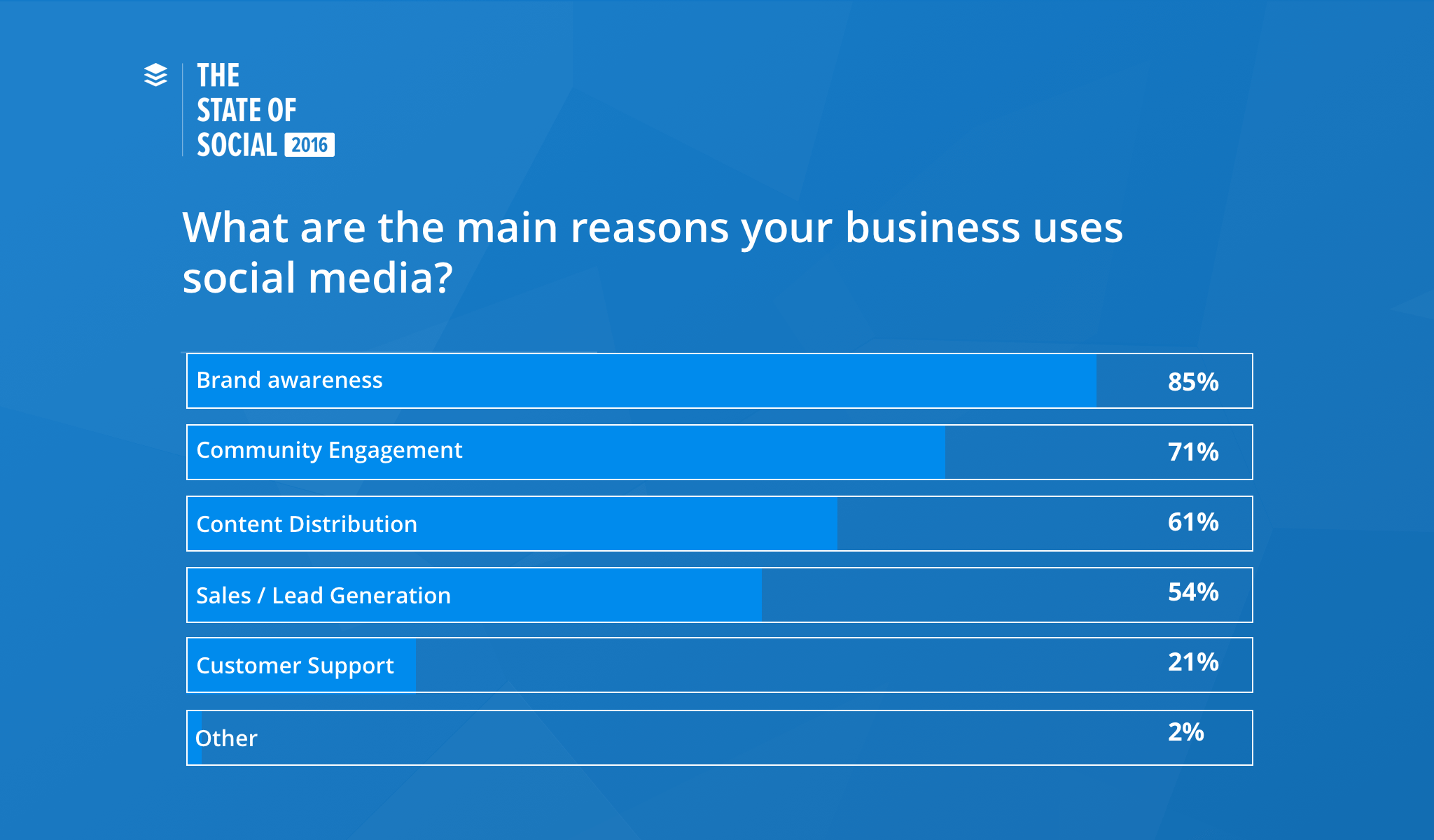
Challenge: More than half of marketers are keen to figure out how to drive traffic from social media.
Fifty-eight percent of marketers said that driving traffic to their website was one of their main social media challenges, followed by generating leads (49%).
Measurement and ROI continue to present problems for a large percentage of marketers, too, with 42% of our respondents listing it as a challenge they’re facing.

—
How marketers are using social media platforms: 10 insights you need to know
1. Facebook is still the leading platform for marketers (93% of businesses use Facebook)
Facebook is the leading platform for marketers with 93% saying their business is actively using it. Twitter was close behind with 89% of respondents saying they use the platform for their business.
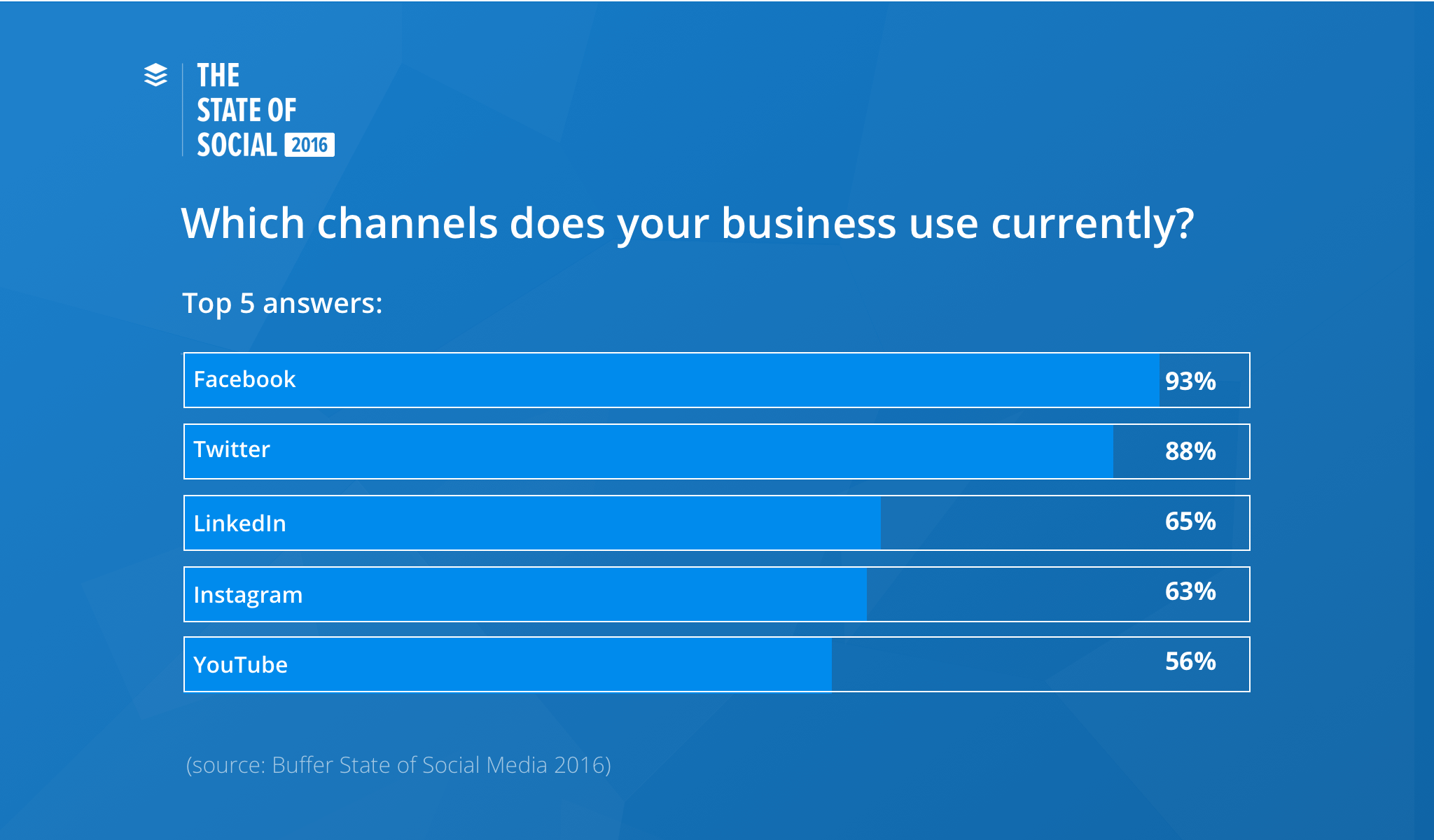
Other channels respondents use include – Google+ (42%), Pinterest (35%), Facebook video (29%), Messaging Apps (16%), Snapchat (12%), Medium (10%), Quora (5%), Vine (3%).
2. Marketers are beginning to abandon Google+ (27% said they’ll use Google+ less in 2017)
Our survey results show that Google+ is the channel most marketers feel they will invest less time in over the next 12 months (27% of respondents). Twitter followed up in second with 23%.

Other channels respondents said they’ll move away from in 2017 include – Instagram (11%), Snapchat (9%), YouTube (9%), Messaging Apps (8%), Facebook video (6%), Quora (6%), Medium(6%).
3. Facebook video is a priority for marketers in 2017 (30% of marketers want to invest more in Facebook video)
Multimedia content appears to be top of mind for many marketers as they look ahead to 2017, with many marketers believing video will help them win in the future.
Facebook video came out top of the pile here, with 30% of respondents saying it’s on their radar for 2017, closely followed by YouTube (28%), Instagram (26%), and Snapchat (22%). All four of these platforms focus on video and visual content, which seems to point at marketers focused on more multimedia content in 2017. The inclusion of YouTube so prominently in these results is telling also, as it doesn’t get mentioned as often in the discussion of up-and-coming video options (though is clearly top-of-mind for a lot of marketers).
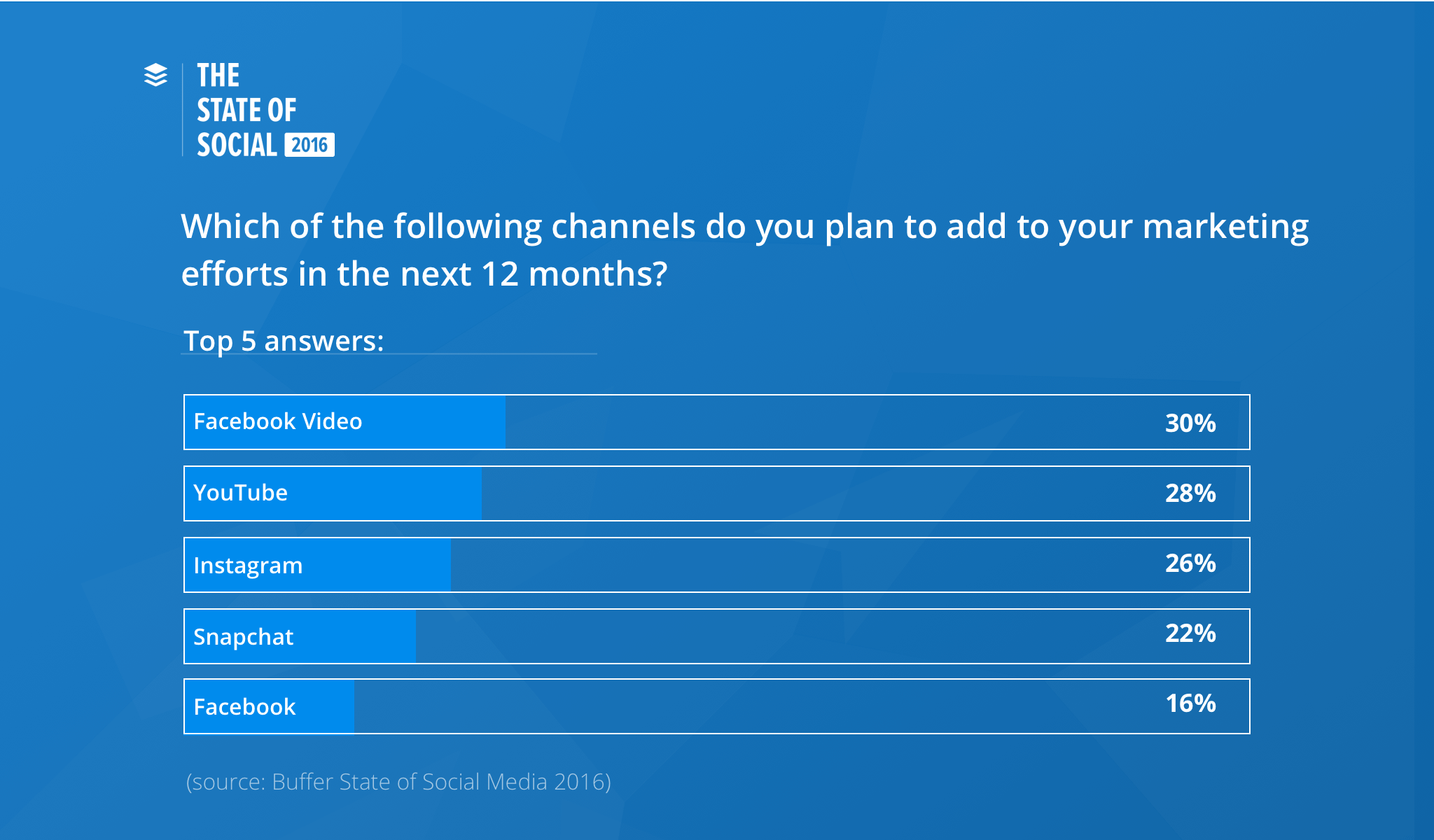
Other channels respondents plan to add to their marketing strategy include – Pinterest (15%), LinkedIn (14%), Twitter (13%), Messaging Apps (11%), Medium (11%), Google+ (10%), Quora (6%).
4. Facebook’s decline in organic reach isn’t scaring away marketers (72% of marketers use Facebook the same amount or more that the previous 12 months)
Despite Facebook organic reach continuing to drop over the past year, the majority of businesses are still actively using the platform: 46% of respondents said that their use of Facebook has stayed the same, with 26% saying they now share more content despite the drop in reach and 28% said they now post less.
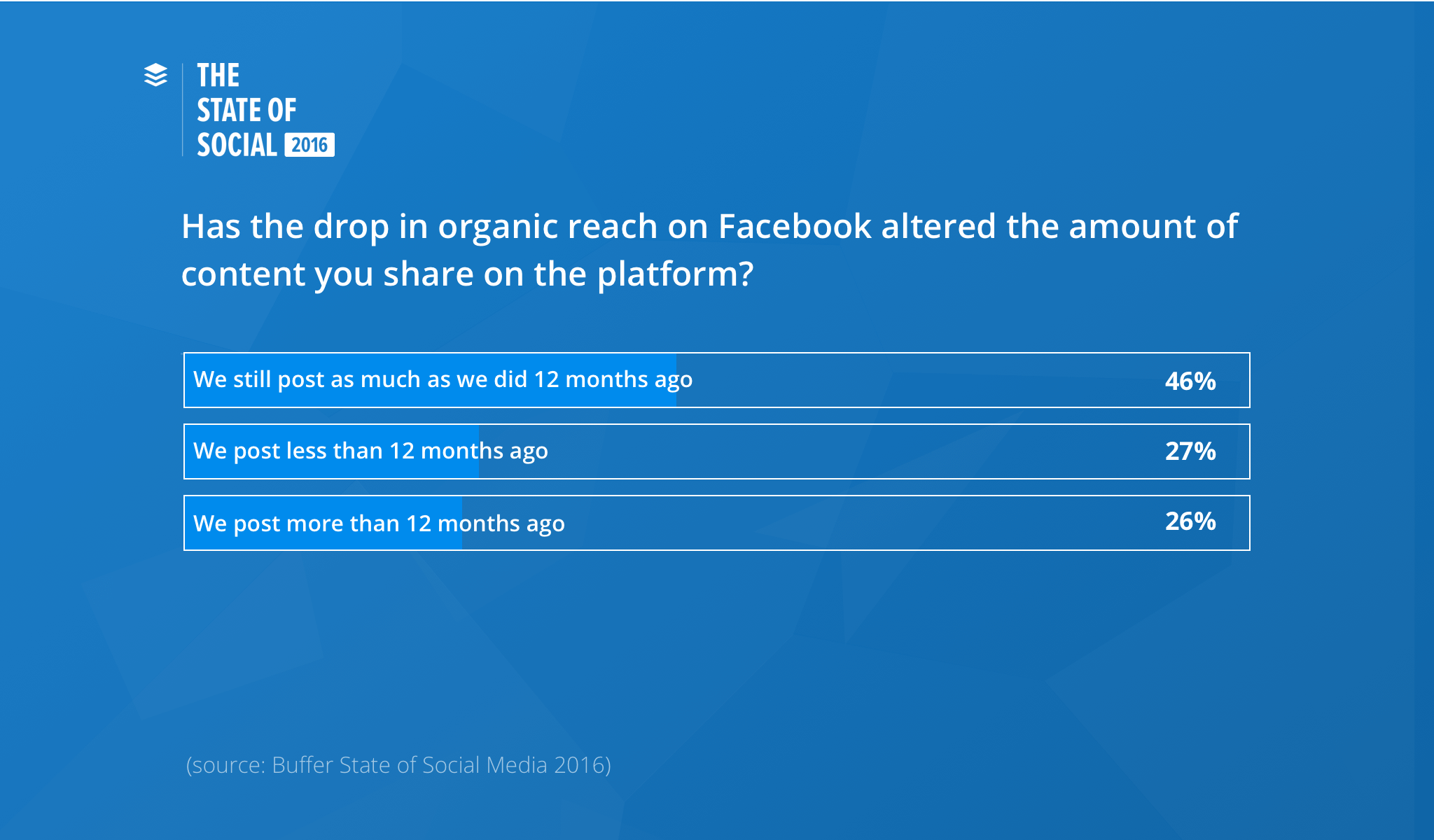
5. Businesses are adapting to Facebook as a pay-to-play channel (91% of marketers have invested in Facebook ads)
Facebook appears to be the leader when it comes to paid marketing spend. From the survey, 91% of respondents said investing in ads on the platform — way ahead of Twitter, which finished second with 34% of respondents saying they’d used Twitter ads.

6. Social media spend is stable (only 7% of companies are decreasing their social media marketing budgets)
Social media marketing seems to have become a staple of marketing budgets at the majority of businesses. In 2016, 42% of respondents saw an increase in spend compared to 2015, with only 7% of companies decreasing their social media marketing budgets. The majority of respondents, 51%, saw their budget stay the same as the previous year.

7. If there were no obstacles like time, resources, and budget … 83% of marketers would like to create more video content
This data appears to again highlight that marketers are accounting for the rise in popularity of video content.
If there were no obstacles (time, resources, budget), 83% of marketers said they’d create more video content. Interestingly, live video was third with 42% of marketers choosing this option. Blog posts finished second (57%).

8. Time restraints are holding marketers back from creating video (73% say time is the main reason they don’t create more video)
From the survey, 73% of marketers attribute a lack of time to be the reason they’re yet to create video content. The perceived cost of creating video was also a key reason why many are yet to experiment, with 41% of respondents saying cost was the reason they don’t create more videos.
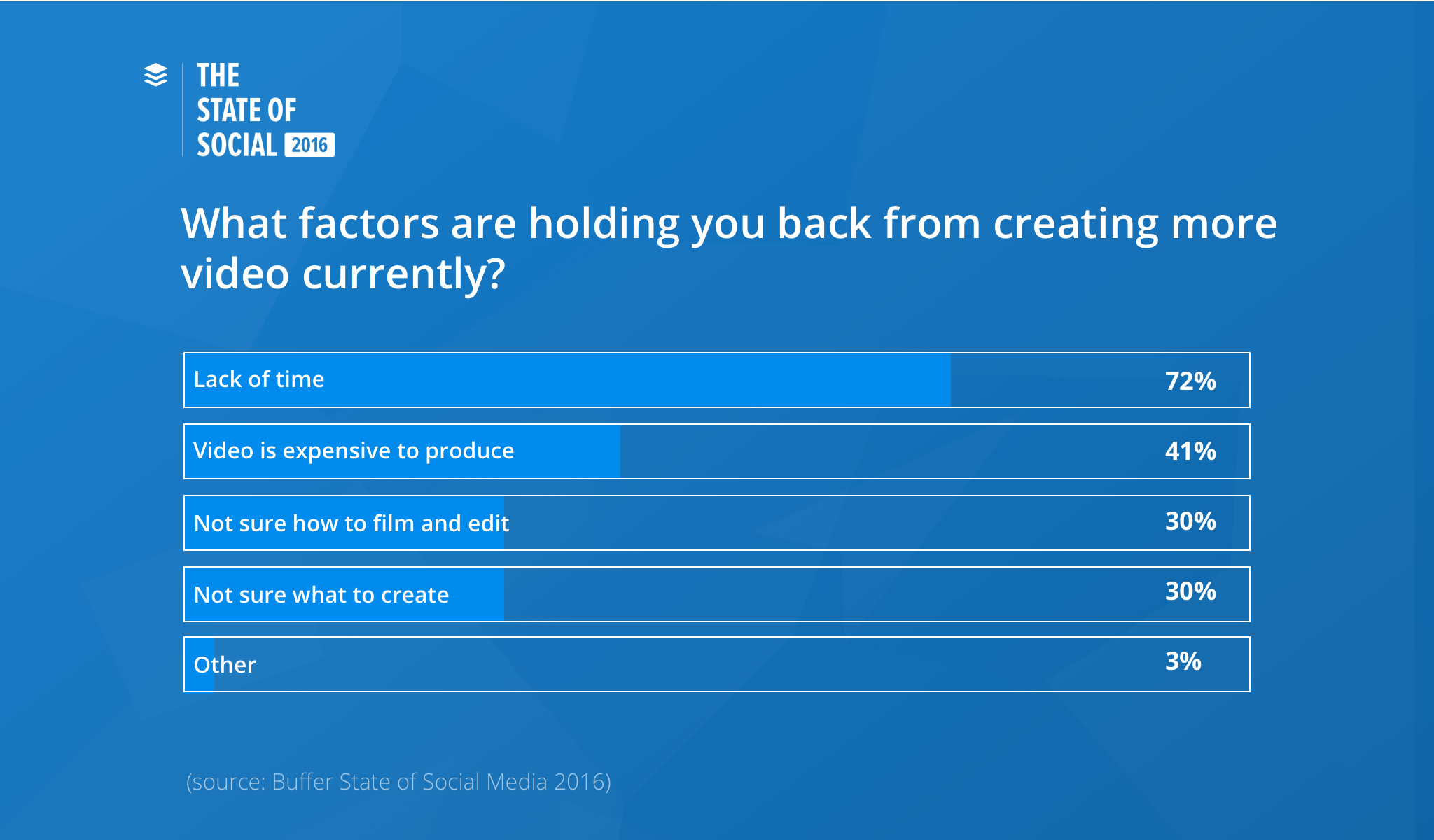
(Perhaps these resources could help?)
9. Live video is yet to hit mass adoption (Only 26% of marketers have created live video content)
Despite the excitement around live video during 2016, the majority of marketers (74%) have yet to begin experimenting with live video content:
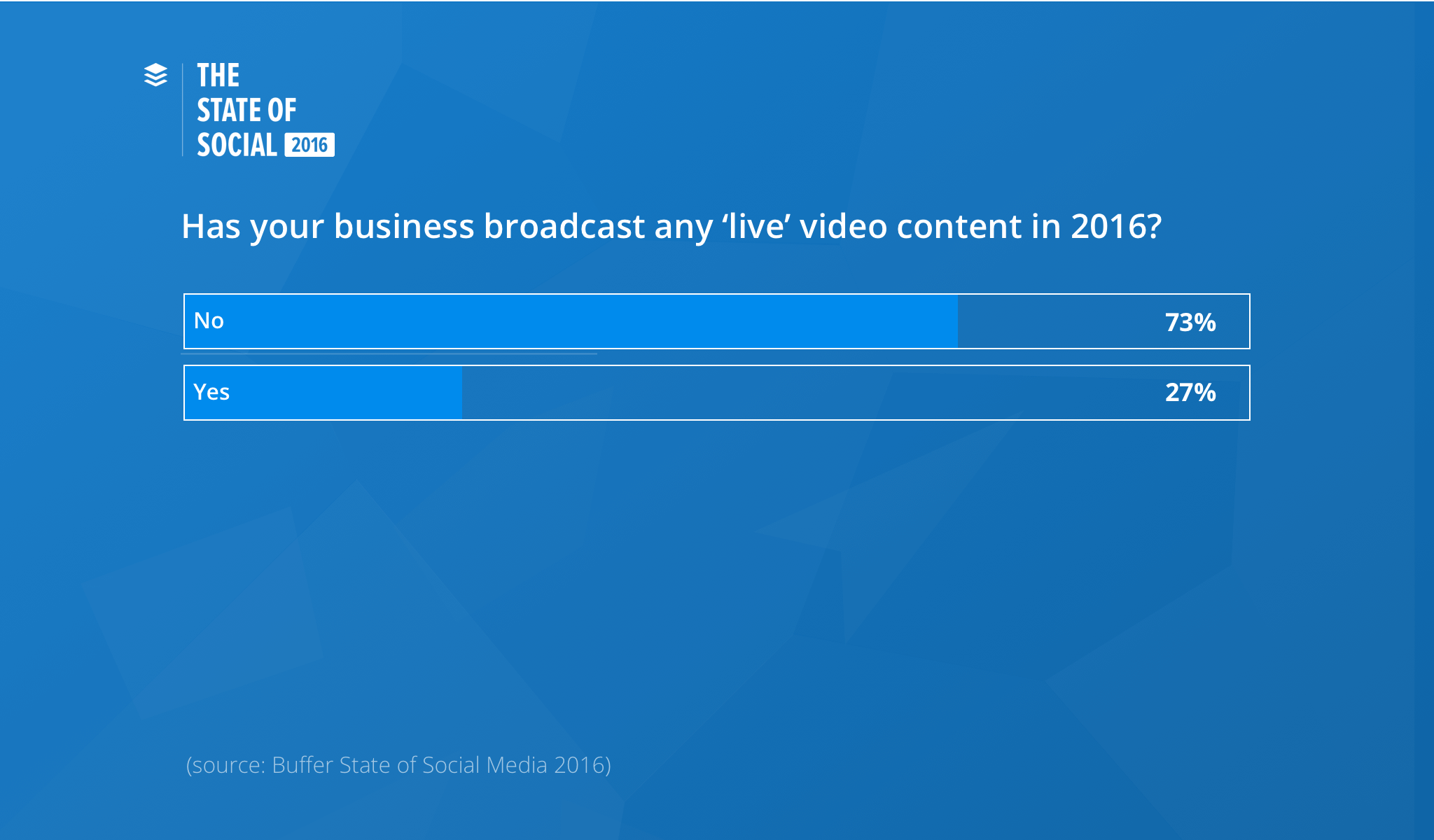
For those who have created live video, Facebook Live was the number one platform of choice, ahead of Periscope and YouTube:

10. Marketers are still figuring out Snapchat and Instagram stories (Only 29% of marketers have created stories)
It seems that marketers are excited about the potential of Instagram and Snapchat, with 26% and 22% of marketers saying they’re looking to add the platforms to their marketing channels in the next 12 months. Despite this, 71% of marketers are yet to create stories on either platform.

Looking ahead to 2017, 37% of respondents said they won’t be looking to create stories on either Snapchat or Instagram, with 34% looking to create stories on Instagram and 27% looking to use stories on both platforms.
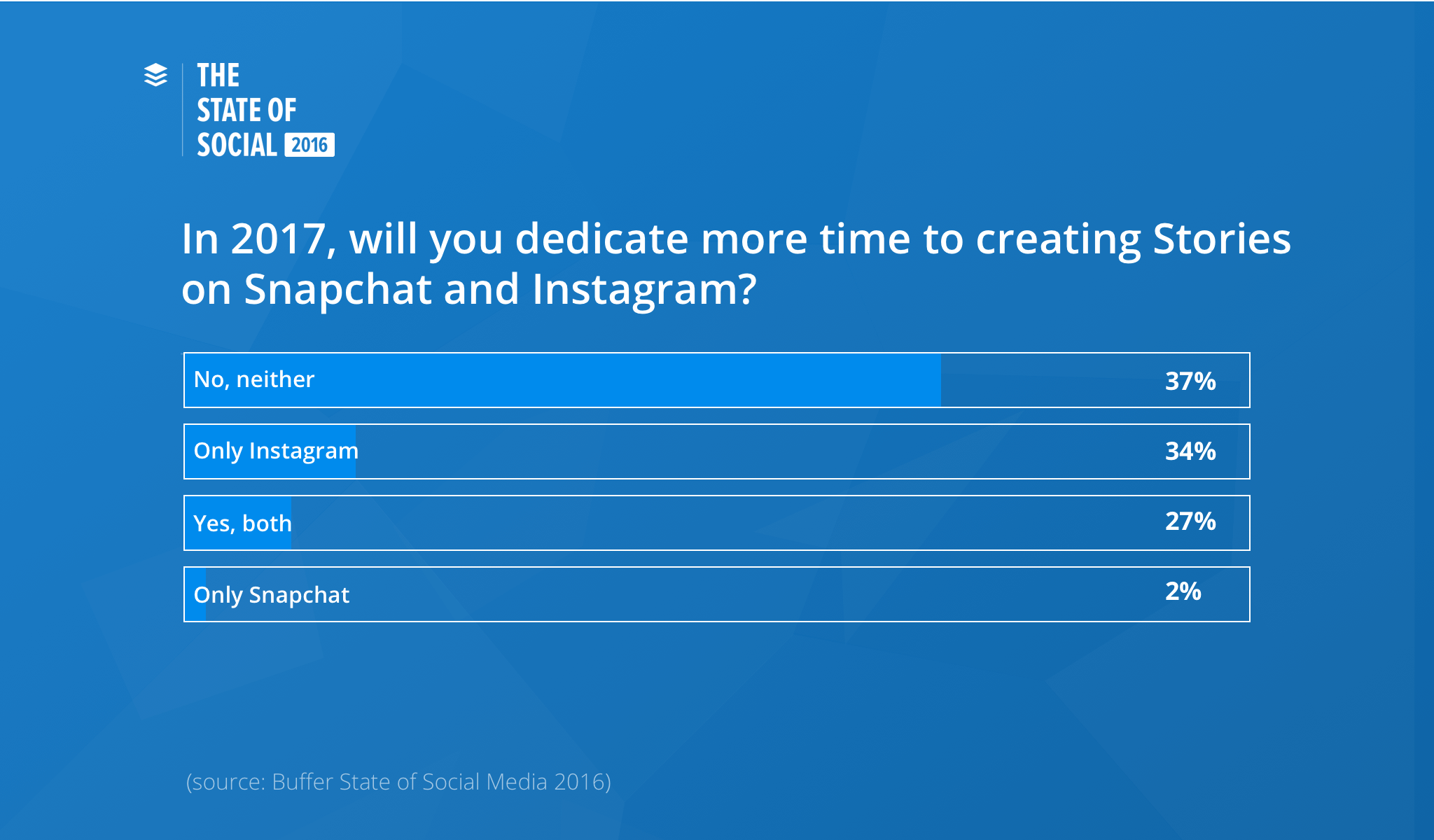
—
The evolution of social media marketing roles
Social media marketing roles are changing (Only 15% of respondents work full-time on social media)
Of our respondents, only 15% worked full time on social media, with 80% of respondents agreeing with the statement “social media is only a part of my role.”

This feels like a really interesting trend to keep an eye on during 2017. Are we beginning to see a shift in social media marketing roles? It feels like the lines between social media and other forms of brand communications are blurring a little.
What other areas do social media marketers work on? (84% of social media marketers also work on content marketing)
To dig a little deeper into the structure of social media and marketing roles, we asked the respondents who said social media was only a part of their role to share what other areas they worked on within the business.
- 84% also do content marketing alongside social media
- 68% also do email marketing alongside social media
- 62% combine social media with community focused projects
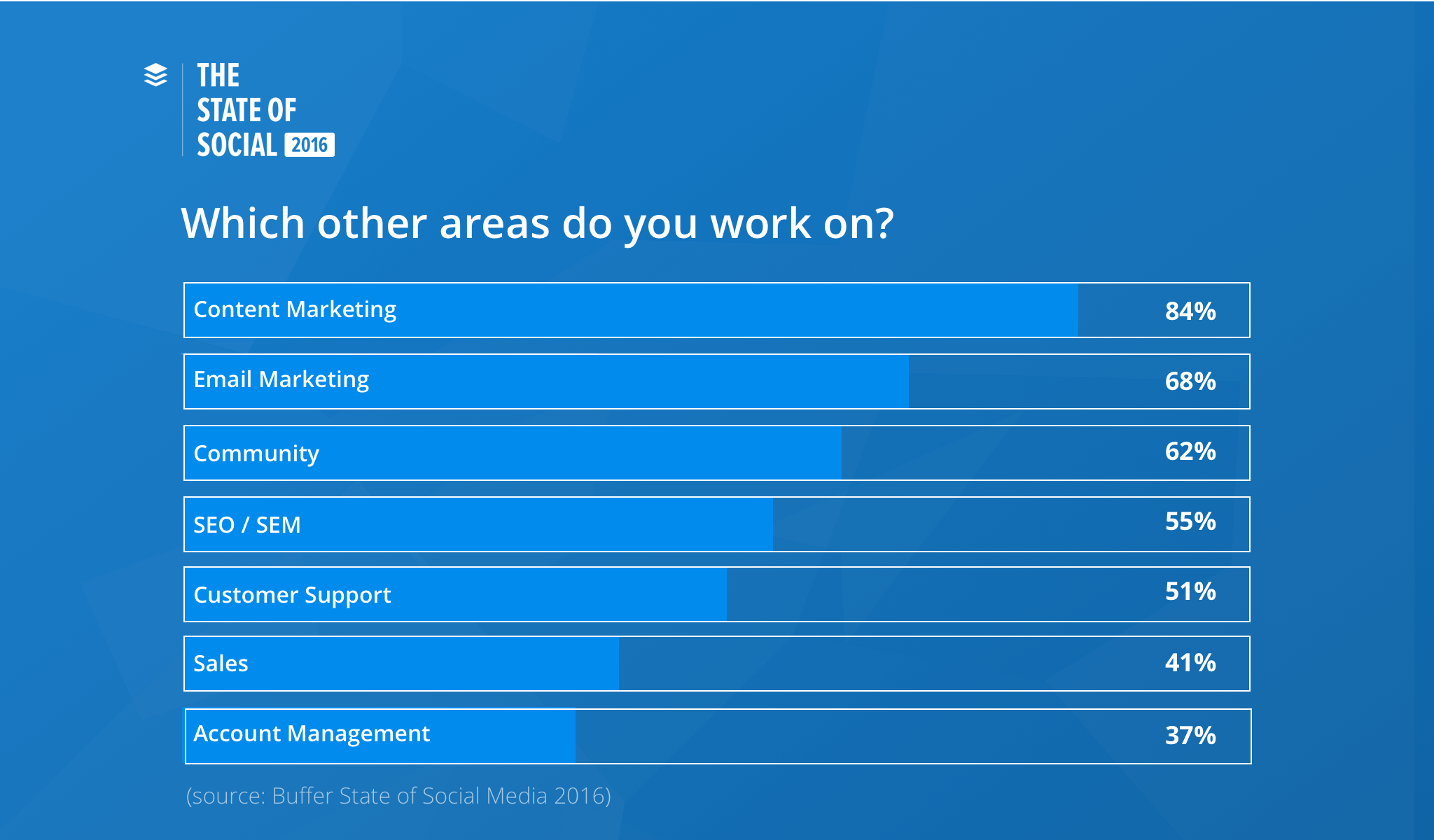
With so much of social media success relying on stand-out content, it makes sense that social media marketers would combine their social media role with content marketing.
With email marketing being the second most popular answer, this could also point to social media roles transitioning more into brand communication roles, where social media managers take on responsibility for the tone, voice, and content of all public-facing messaging.
—
The data: Who took part in the survey?
For this report, we surveyed over 1,200 marketers from businesses of all sizes. The majority of respondents are B2B or B2C marketers in small businesses, with 55% of our respondents working at businesses with 1-10 employees. At the other of the scale, 7% of respondents work at companies with over 200 employees.
Company size
Over half (54%) of the people who took our survey work at companies with fewer than 10 full-time staff. A further 20% work at companies with between 11-50 full-time team members. Here’s the full breakdown:
- 54%: Fewer than 10 people
- 12%: 11-25 people
- 8%: 26-50 people
- 7%: 1,001+ people
- 7%: 51-100 people
- 5%: 101-200 people
- 4%: 201-500 people
- 3%: 501-1,000 people
Marketing team size
The majority of respondents in our survey work closely with a small number of colleagues in their marketing teams or act as the sole marketer at their company:
- 46% of respondents were the only marketer at their company
- 39% of people worked in marketing teams of between 2-5 colleagues
- 8% of people work in marketing teams larger than 11 people
- 7% of people work in marketing teams of between 6-10
Industry breakdown
Twenty-one percent of those who took the survey work at organizations in the marketing, PR, and advertising space. Other industries include: Media and Publishing (10%); Education (10%); Non-Profit (8%); IT & Services (7%); Consumer Products (7%); Software (5%); E-commerce (4%); Medical & Healthcare (3%); Travel & Tourism (3%); Financial Services (2%); Government (2%); Law & Legal Services (1%); Financial (1%); Other (15%).
—
Over to you
Thanks so much for checking out our State of Social 2016 report. We hope you enjoyed the data and discovered some useful takeaways for your business.
We’d love to continue the conversation and hear your thoughts – feel free to share in the comments or join the conversation on Twitter using #StateofSocial16. ?
P.S. We’ve made the data open and available to anyone in this Google Sheet (feel free to make a copy and interrogate in any way you’d like – we’d love to hear what you might find).
Try Buffer for free
140,000+ small businesses like yours use Buffer to build their brand on social media every month
Get started nowRelated Articles

In this article, Nupur Mittal shares insights into four research methods that help her find content ideas and identify unique takeaways.

Facebook marketing in 2019 isn’t dead. On the contrary, it’s far from it. Now removed from the dim outlook that businesses faced at the beginning of 2018, Facebook has and will remain an essential tool for brands’ marketing strategies moving forward. In our big State of Social Media 2019 Report, we found that 93.7 percent of businesses use and are currently active on Facebook — the most among any other social media network. And although we continue to see a dramatic rise in the usage

